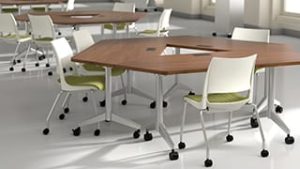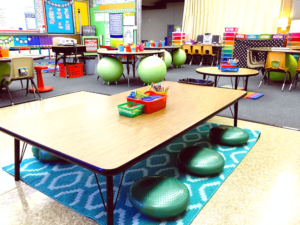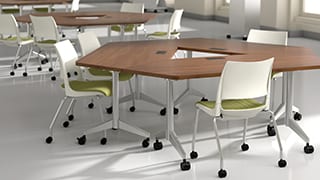Student Contributor: C. Rothwell
 Seating students in tables rather than desks lined in rows allows for collaboration to take place among the students. This tool can be helpful for student understanding, as a formative assessment tool, and a way to teach our students pro-social skills.
Seating students in tables rather than desks lined in rows allows for collaboration to take place among the students. This tool can be helpful for student understanding, as a formative assessment tool, and a way to teach our students pro-social skills.
One common theme that has encompassed the classroom over the years has been seating students at desks lined up in rigid rows that face the front of the classroom, where the focus is solely on the teacher. Students may look like they are listening and engaging with the lesson, but many times it may be passive engagement. By implementing tables instead of desks, students can be seated in clusters of 4-5 at each table, allowing for multiple opportunities to collaborate with each other and hear a variety of ideas around the same topic. This helps students make deeper connections with the material to better understand it. This is also a great formative assessment tool for teachers because when discussions take place among the table groups, the teacher can walk around and audibly hear where each student is at with their understanding of the material. This is also a great classroom management tool because within groups, there is bound to be conflict. Teachers can use opportunities of conflict within table groups to teach those students the life skills of patience, cooperation, perseverance, and problem solving to resolve the conflict. This is to help prepare our young students to become aware of and build up these qualities within themselves.
 I placed the tables instead of desks in the Preventative category because that is the best fit. The tables instead of desks is a tool you need to set up at the beginning of the year before it will be effective. It relates to the Supportive phase because that is when it actually gets used. But in that way, one might argue that everything in the Preventative phase is also supportive. The relationship the tables might have to the Corrective phase would be that some of the corrective issues you face could be solved by better teaching pro-social skills and expectations of collaborating with others. The use of the tables instead of desks could fit any theory of influence; however, it probably best fits the Student Directed and Collaborative theories. I say this because the purpose in using tables instead of desks is based on allowing for student collaboration, which is compatible with student brains.
I placed the tables instead of desks in the Preventative category because that is the best fit. The tables instead of desks is a tool you need to set up at the beginning of the year before it will be effective. It relates to the Supportive phase because that is when it actually gets used. But in that way, one might argue that everything in the Preventative phase is also supportive. The relationship the tables might have to the Corrective phase would be that some of the corrective issues you face could be solved by better teaching pro-social skills and expectations of collaborating with others. The use of the tables instead of desks could fit any theory of influence; however, it probably best fits the Student Directed and Collaborative theories. I say this because the purpose in using tables instead of desks is based on allowing for student collaboration, which is compatible with student brains.
More Information –
Tool Source: Kovalik, S., & Olsen, K. (2005) Exceeding expectations: A user's guide to implementing brain research in the classroom (3rd ed.). Federal Way, WA: Books for Educators, Inc. Evertson, C. M. & Emmer, E. T. (2009). Classroom management: For elementary teachers (8th ed.). Upper Saddle River, NJ: Pearson.


